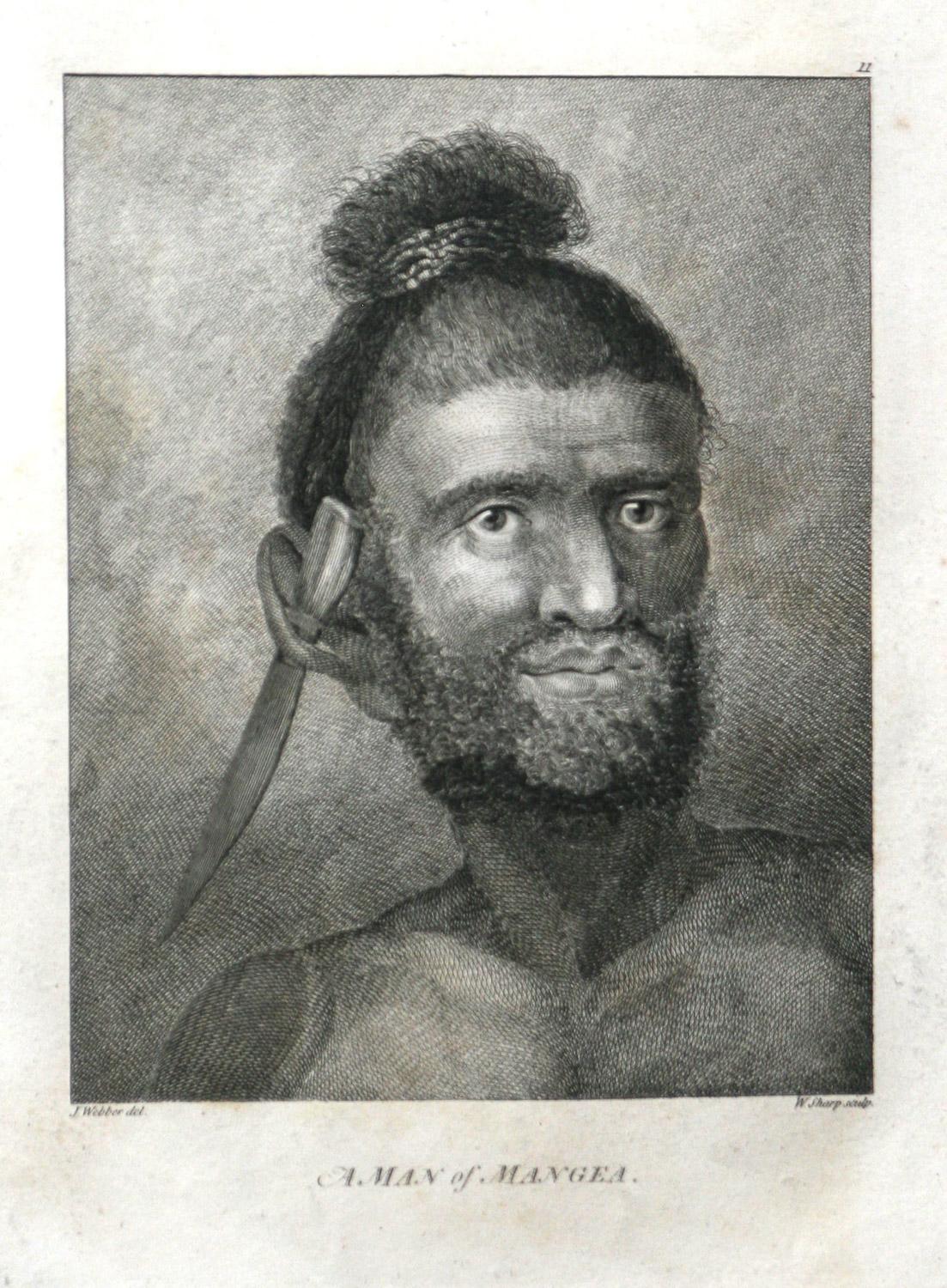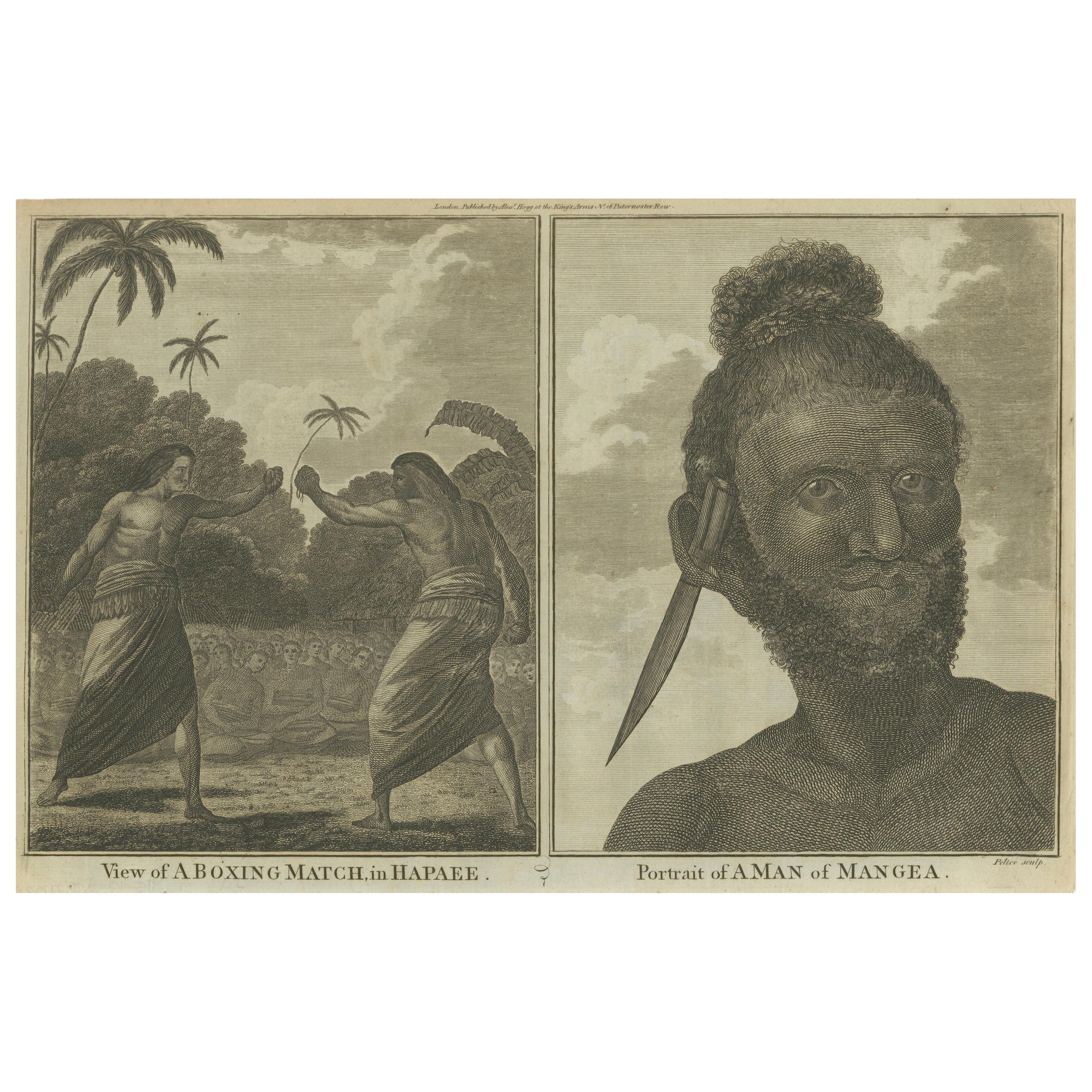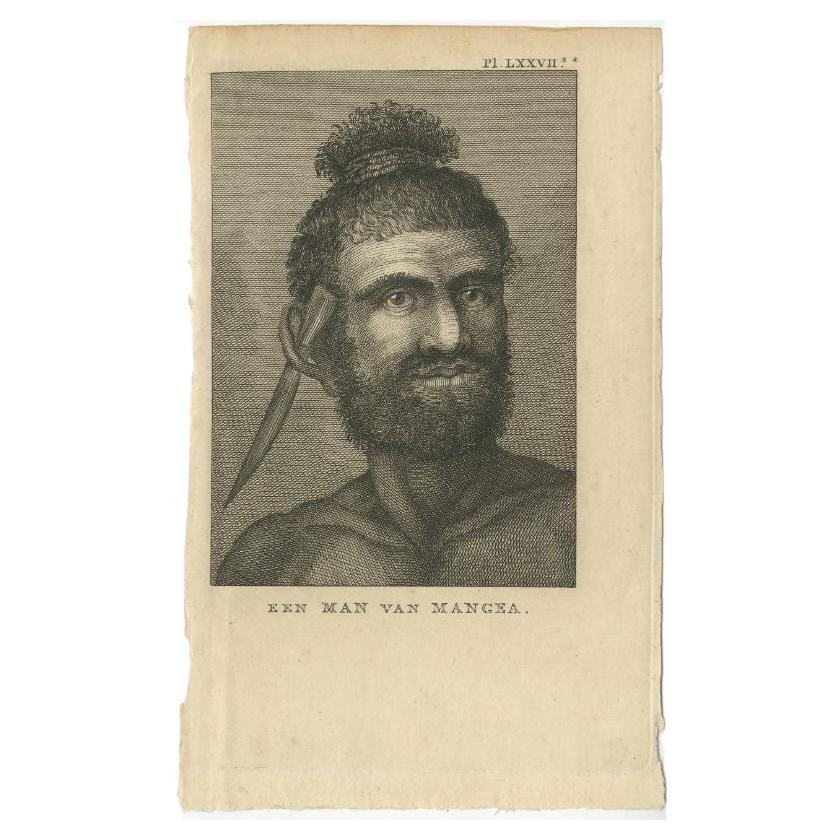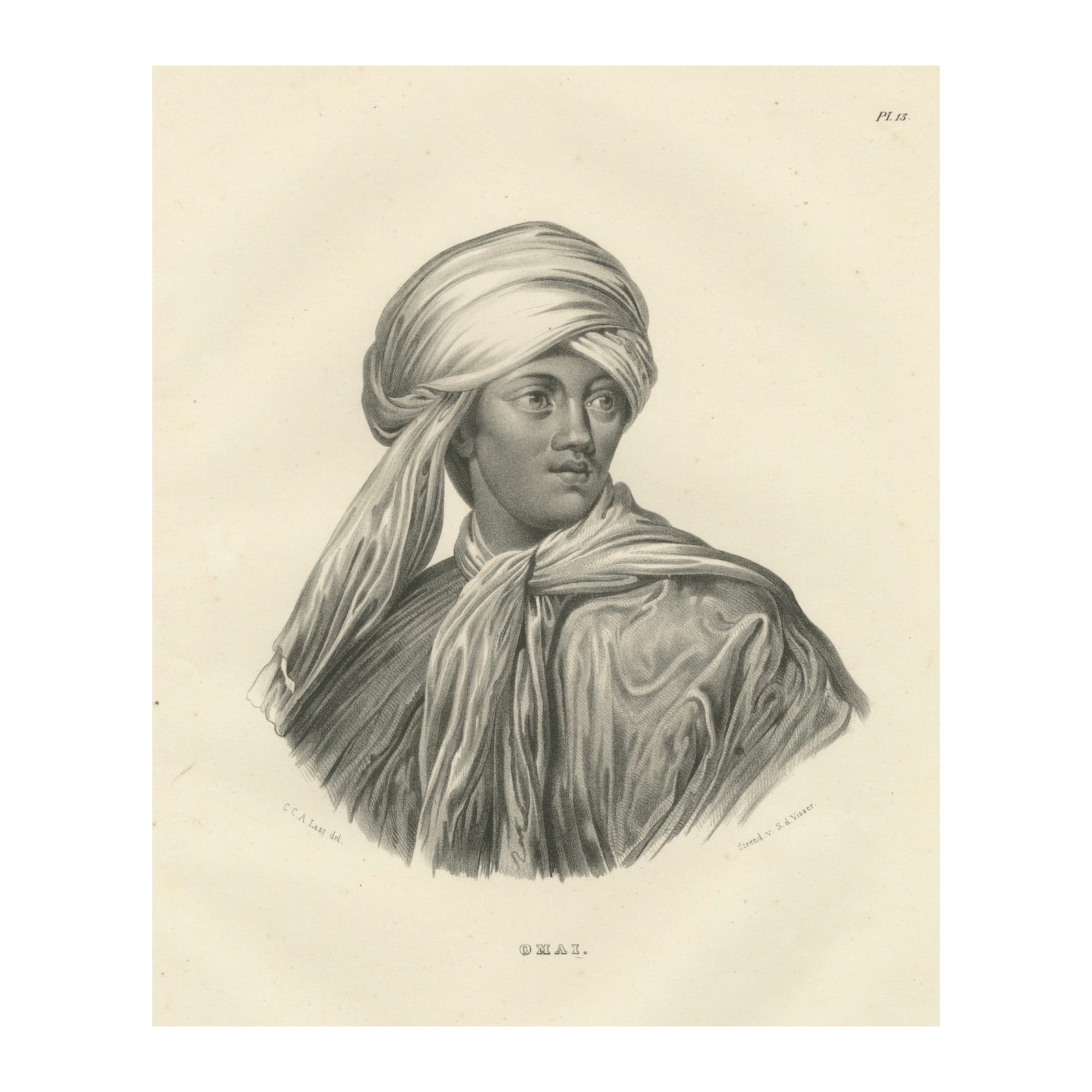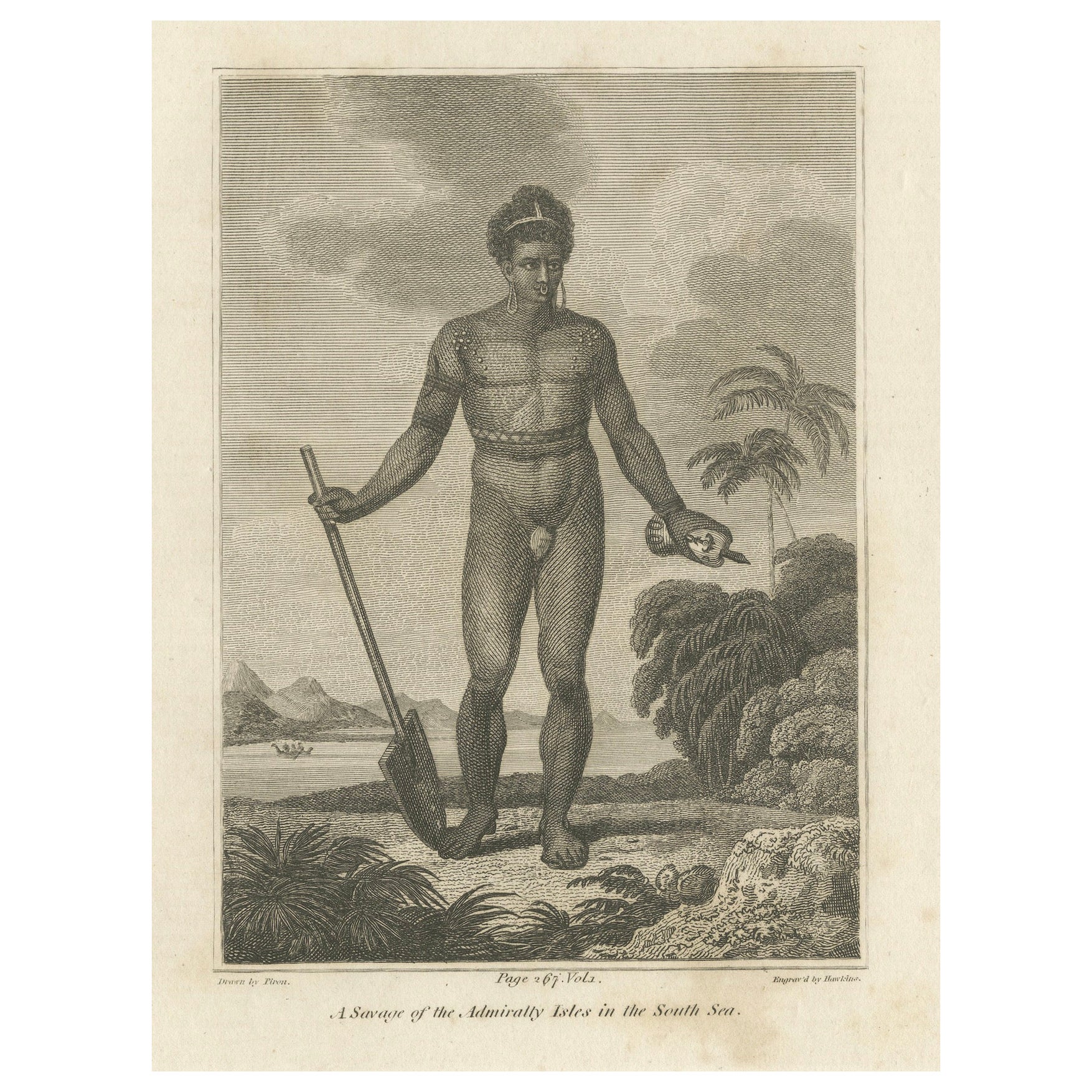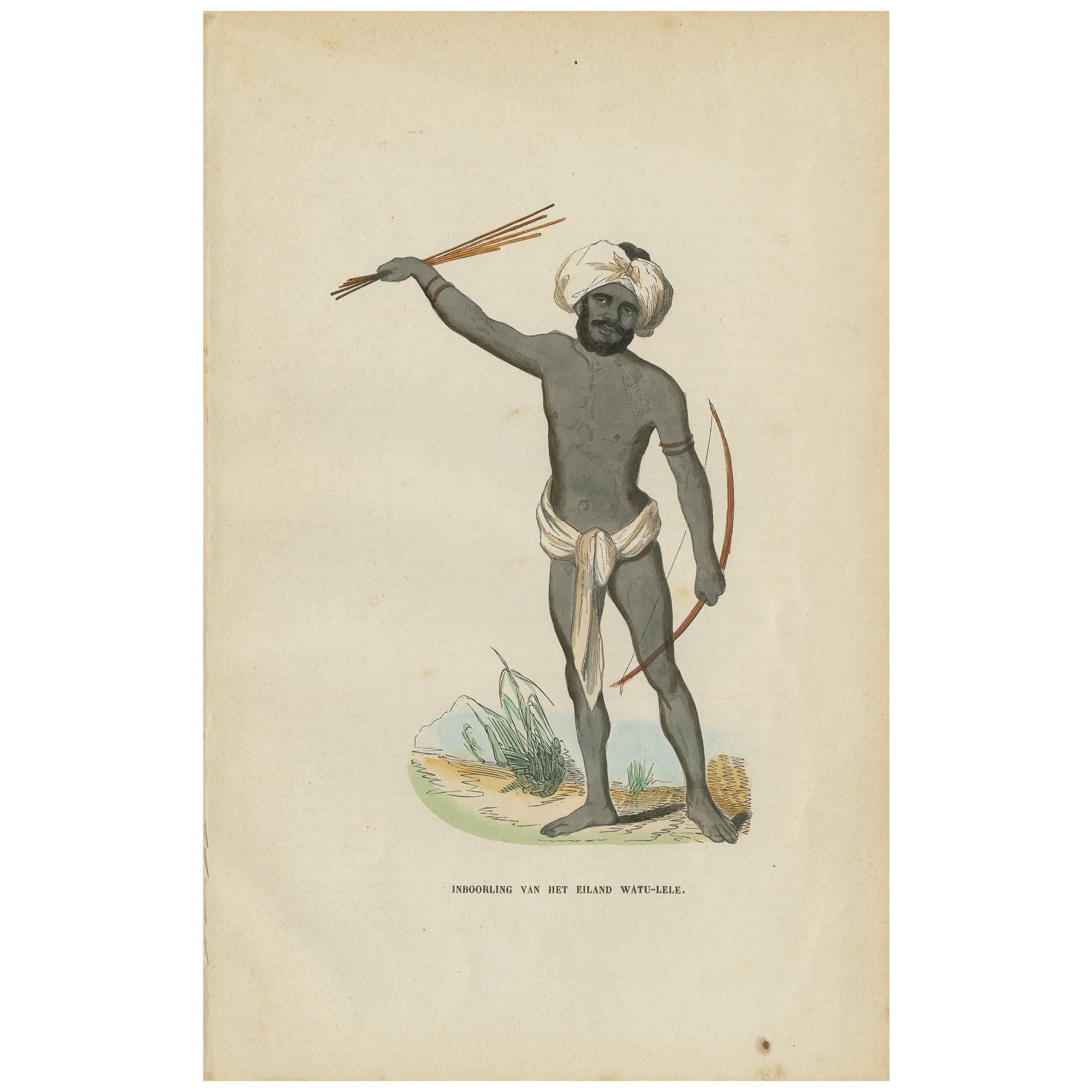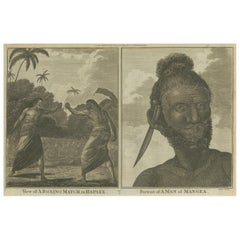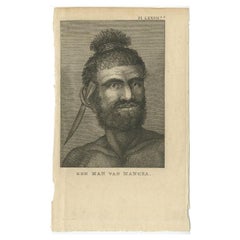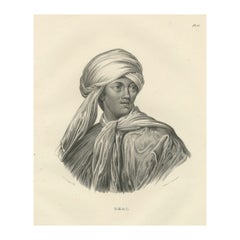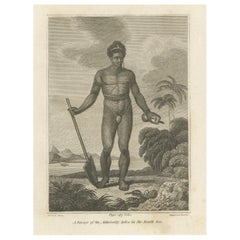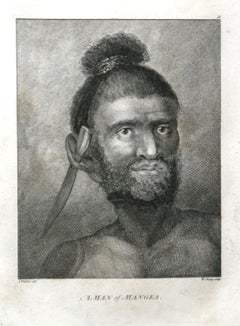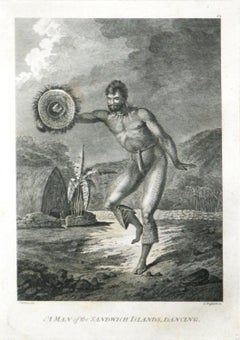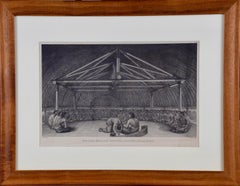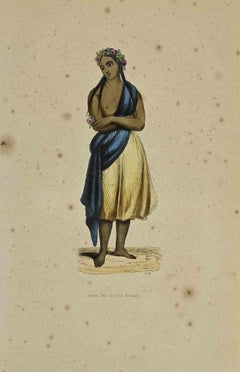Items Similar to Portrait of a Mangean Islander in The South Pacific by John Webber, circa 1800
Want more images or videos?
Request additional images or videos from the seller
1 of 6
Portrait of a Mangean Islander in The South Pacific by John Webber, circa 1800
$134.15
$167.6820% Off
£99.41
£124.2620% Off
€112
€14020% Off
CA$183.14
CA$228.9220% Off
A$203.73
A$254.6620% Off
CHF 106.80
CHF 133.5020% Off
MX$2,489.55
MX$3,111.9320% Off
NOK 1,359.95
NOK 1,699.9320% Off
SEK 1,280.20
SEK 1,600.2520% Off
DKK 852.76
DKK 1,065.9520% Off
Shipping
Retrieving quote...The 1stDibs Promise:
Authenticity Guarantee,
Money-Back Guarantee,
24-Hour Cancellation
About the Item
A head and shoulders frontal portrait of a man named by Cook as Mourua, of Mangaia, Cook Islands, visited by Cook in March 1777.
Title: "Portrait of a Mangean Islander by John Webber"
Description: This striking engraving by A. Warren, based on the artwork of John Webber, offers a glimpse into the visage of a man from Mangea, an island in the South Pacific Ocean. Webber, the official artist on Captain James Cook's third voyage, was renowned for his detailed and humanizing portrayals of indigenous peoples encountered during the expedition. This piece likely dates from the late 18th century, during a period of European exploration that sought to document and understand the wider world. The man is depicted with a distinctive hairstyle and facial features, set against a backdrop of clouds, symbolizing the remote and ethereal nature of his homeland.
- Dimensions:Height: 10.44 in (26.5 cm)Width: 8.08 in (20.5 cm)Depth: 0 in (0.02 mm)
- Materials and Techniques:Paper,Engraved
- Period:
- Date of Manufacture:circa 1800
- Condition:Good. Soiling and some browning due to age and handlng, mostly around the edges. One small chip in left top corner missing but plate mark with image intact. Check the image carefully.
- Seller Location:Langweer, NL
- Reference Number:Seller: BG-13597-81stDibs: LU3054337816392
About the Seller
5.0
Recognized Seller
These prestigious sellers are industry leaders and represent the highest echelon for item quality and design.
Platinum Seller
Premium sellers with a 4.7+ rating and 24-hour response times
Established in 2009
1stDibs seller since 2017
2,494 sales on 1stDibs
Typical response time: 1 hour
- ShippingRetrieving quote...Shipping from: Langweer, Netherlands
- Return Policy
Authenticity Guarantee
In the unlikely event there’s an issue with an item’s authenticity, contact us within 1 year for a full refund. DetailsMoney-Back Guarantee
If your item is not as described, is damaged in transit, or does not arrive, contact us within 7 days for a full refund. Details24-Hour Cancellation
You have a 24-hour grace period in which to reconsider your purchase, with no questions asked.Vetted Professional Sellers
Our world-class sellers must adhere to strict standards for service and quality, maintaining the integrity of our listings.Price-Match Guarantee
If you find that a seller listed the same item for a lower price elsewhere, we’ll match it.Trusted Global Delivery
Our best-in-class carrier network provides specialized shipping options worldwide, including custom delivery.More From This Seller
View AllTraditions and Faces of the Pacific: Boxing in Ha'apai and a Man of Mangea, 1785
Located in Langweer, NL
The engraving appears to be from the Captain James Cook's voyages, which took place between 1768 and 1779. Since it is related to Cook's expeditions and given the style of the engrav...
Category
Antique 1780s Prints
Materials
Paper
$210 Sale Price
20% Off
Antique Print of a Man of Mangaia by Cook, 1803
By Cook
Located in Langweer, NL
Antique print titled 'Een Man van Mangeea'. Antique print depicting a man of Mangaia, Cook Islands. Originates from 'Reizen Rondom de Waereld door James Cook (..)'.
Artists and E...
Category
Antique 19th Century Prints
Materials
Paper
$182 Sale Price
20% Off
Portrait of Omai, a Polynesian Man, by Karl Joseph Brodtmann, 1835
Located in Langweer, NL
This lithograph, titled Omai, by Karl Joseph Brodtmann, is an example of the artist’s ethnographic studies, showcasing a portrait of Omai, a notable figure from Polynesia who visited Europe in the 18th century. This work highlights Brodtmann’s interest in portraying individuals from distant lands, focusing on their unique cultural attire and expressions.
Description:
The portrait represents Omai, a Polynesian man who gained historical significance during the 18th century as one of the first Polynesians to travel to Europe. Omai (also known as Mai) was a central figure in the encounters between Polynesian and European cultures, having been brought to England by Captain James Cook in the 1770s.
- Clothing: Omai is depicted in an elegant wrap of flowing fabric, draped around his shoulders and tied in a loose, elegant fashion. His head is adorned with a large turban, a stylistic interpretation that may have been influenced by European artistic conventions when portraying foreign dignitaries or exotic figures. The fabric's folds and shading add a sense of depth and texture, showcasing Brodtmann’s mastery of lithography.
- Expression: Omai’s expression is poised and dignified, with his gaze directed slightly off to the side. The sense of serenity and composure in his face is typical of the European portrayals of him as an "exotic noble savage," a term that reflects the European fascination with non-Western peoples during the age of exploration.
The lithograph highlights both the individuality of Omai and the cultural significance of his travels to Europe, where he became a symbol of cross-cultural exchange and curiosity during the 18th century.
Maker:
Karl Joseph Brodtmann (1787–1862), the Swiss lithographer, was known for his detailed illustrations of people from various cultures, natural history subjects, and scientific studies. His ethnographic works were part of a broader effort in 19th-century Europe to document the physical and cultural characteristics of peoples encountered through exploration. Brodtmann’s portraits often struck a balance between realism and the romanticized European views of non-Western cultures.
Technique and Style:
Brodtmann created this portrait using lithography, a technique that allowed him to achieve fine details and subtle gradations of light and shadow. His style in this portrait combines realism with the romanticized ideal of the "exotic," particularly in the way Omai is dressed in flowing garments, which may not be entirely representative of traditional Polynesian dress...
Category
Antique 1830s Prints
Materials
Paper
$421 Sale Price
20% Off
Engraving of A Savage of the Admiralty Isles in the Bismarck Archipelago, 1801
Located in Langweer, NL
The 1801 engraving depicts a figure labeled as "A Savage of the Admiralty Isles in the South Sea." The image portrays a solitary indigenous man standing with a paddle in hand, exudin...
Category
Antique Early 1800s Prints
Materials
Paper
$325 Sale Price
20% Off
Free Shipping
Antique Print of a Vatulele Island Native ‘Fiji’ by H. Berghaus, 1855
Located in Langweer, NL
This print originates from the first volume of ‘De Volken van den Aardbodem (..)’ by dr. H. Berghaus. Published by G.B. van Goor, Gouda, 1855. Dutch edition.
Category
Antique Mid-19th Century Prints
Materials
Paper
$134 Sale Price
20% Off
A Tattooed Man from Nuku Hiva, French Polynesia, by Karl Joseph Brodtmann, 1836
Located in Langweer, NL
This lithograph by Karl Joseph Brodtmann presents a tattooed man from Nuku Hiva, an island in the Marquesas Islands, located in French Polynesia. The artwork captures the intricate a...
Category
Antique 1830s Prints
Materials
Paper
$395 Sale Price
25% Off
You May Also Like
A Man of Mangea 1784 final voyage of Captain Cook by John Webber
By John Webber
Located in Paonia, CO
A Man of Mangea is from the 1784 First Edition Atlas Accompanying Capt. James Cook and King; Third and Final Voyage of Captain James Cook. John Webber (1752-1793) was the official a...
Category
1780s Realist Portrait Prints
Materials
Engraving
A Man of the Sandwich Islands, Dancing (Hawaii) from Captain Cooks travels engra
By John Webber
Located in Paonia, CO
A Man of the Sandwich Islands Dancing (Hawaii) is from the 1784 First Edition Atlas Accompanying Capt. James Cook and King; Third and Final Voyage of Captain James Cook. John Webber (1752-1793) was the official artist for the third voyage of Captain James Cook (1728-1779). The purpose of this voyage was to discover the Northwest Passage and to explore the Pacific Ocean north of the Equator. These engravings were published in 1784-85 by G. Nichol and Thomas Cadell of London in the four large format atlas, Voyage to the Pacific Ocean. Captain Cook was an extraordinary explorer known for discovering and mapping unknown territory and for his many contributions to the scientific world. These original engravings from Webber’s drawings and paintings are only a glimpse into this great man’s historical contributions that make him one of the greatest explorers of all times.
This image shows a Hawaiian dancer...
Category
1780s Realist Figurative Prints
Materials
Engraving
"King of the Friendly Islands" (Tonga); Engraving from Captain Cook's 3rd Voyage
By John Webber
Located in Alamo, CA
"Poulaho, King of the Friendly Islands, Drinking Kava" is an engraving created by William Sharp (1749-1824), from a drawing by John Webber (1752-1793), who was the artist on Captain James Cook's 3rd and final voyage of discovery. It was published in the atlas of "A Voyage to the Pacific Ocean Undertaken by the Command of His Majesty, for Making Discoveries in the Northern Hemisphere", the official British Admirality sanctioned journal published upon completion of the voyage in London in 1784 by Strahan & Cadell.
Captain Cook visited Tonga on his 3rd voyage, which he named The Friendly Islands because of the warm welcome he and his crew received, unlike some of the other more hostile Pacific islands. The engraving depicts Cook and his men observed a kava ceremony at the village of Mu’a on Tongatapu. King Paulaho sits in the centre foreground, his back to the spectator with a man kneeling before him. The ceremonial mat depicted behind Paulaho indicates that nobody was allowed to sit behind him. The figure in the centre holds a single cup, referring to the Tongan custom of offering the cup to the king first. Kava is native to the islands of the South Pacific and was first described for English readers in 1768 by Captain James Cook. The kava root has been used for centuries as a central feature of ceremonies and celebrations because it was able to bring about a calming and pleasant social atmosphere. The root was crushed and processed into coconut milk to become the focal ceremonial beverage, simply referred to as kava.
This engraving is presented in a Koa wood frame and a white mat. Koa wood is legendary in Hawaii. There are occasional faint spots, but the print is otherwise in very good condition. This amazing Koa wood is native to Hawaii and it is known for the deep rich colors and varied grain pattern. Koa has an honored heritage in Hawaii and is highly revered and sacred. The word “koa” means “warrior” in Hawaiian. The warriors of King Kamehameha the Great, created canoes and weapons from a wood plentiful on the Big Island of Hawaii. This wood became synonymous with the warriors themselves, and it became known as koa.
There are three other engravings listed from the official journal of Captain Cook's 3rd voyage available that are presented in identical Koa wood frames and mats (LU117324682422, LU117324684052, LU117324684032). They would make a wonderful grouping for a display of 2, 3 or 4 prints. A discount is available for a grouping depending on the number of items included.
Captain Cook is remembered as one of the greatest explorers and navigators in history. His explorations included Australia, New Zealand and islands of the South Pacific and the northwest coast of North America. Hawaii was discovered by Captain Cook during this voyage. Hawaii was originally called The Sandwich Islands in honor of The Earl of Sandwich...
Category
1780s Realist Figurative Prints
Materials
Engraving
Jeune Fille de l'ile Pitcairn - Lithograph by Auguste Wahlen - 1844
Located in Roma, IT
Jeune Fille de l'ile Pitcairn is a hand colored lithograph realized by Auguste Wahlen in 1844.
Good conditions.
The artwork belongsto the Suite Moeurs, usages et costumes de tous l...
Category
1840s Modern Figurative Prints
Materials
Lithograph
A Man of Kamtschatka (Russia) 1784 Captain Cooks Final voyage by John Webber
By John Webber
Located in Paonia, CO
A Man of Kamtschatka (Russia) is from the 1784 First Edition Atlas Accompanying Capt. James Cook and King; Third and Final Voyage of Captain James Cook. John Webber (1752-1793) was t...
Category
1780s Realist Figurative Prints
Materials
Engraving
Man of the Sandwich Islands, with His Helmet J. Webber del. J.K. Sherwin Sc.
By John Webber
Located in Vancouver, British Columbia
An English 18 century engraving titled "Man of the Sandwich Islands, with his helmet " signed .J. Webber del. J.K. Sherwin sc. The subject was sk...
Category
Antique Late 18th Century English British Colonial Prints
Materials
Paper
$1,200 Sale Price
20% Off
More Ways To Browse
Tamil Nadu
Thai Dragons
Thai Statue Wood
Tibetan Buddha Statue
Tiffany Glass Mirror
Tubular Chrome Shelf
Unglazed Clay Jar
Used Metal Storage Bins
Vaseline Uranium Glass
Versaille Urns
Vintage 329
Vintage Banana Leaf
Vintage Bird Toy
Vintage Chime Clock
Vintage Flour
Vintage Glass Mixing Bowls
Vintage Hawaiian Pottery
Vintage Hippie Furniture
